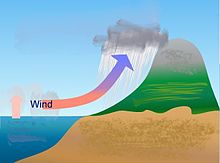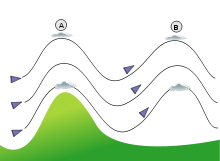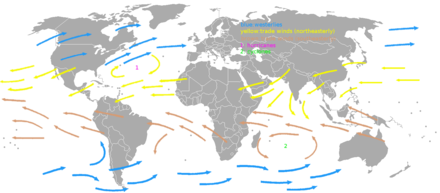Climatology/Air pressure

Introduction
[edit | edit source]Atmosphere is an envelope of gases circling the earth. It is mainly made up colourless and odorless gases of Nitrogen, Oxygen, Carbon-dioxide and many more. Pressure can be defined as the force exerted by the atmosphere at a given place and time. Generally it is expressed in millibar (mb). The atmospheric pressure is determined by the mass of a column of air lying above a certain level or surface. The increase or decrease in pressure of the air is determined by various factors. Atmospheric pressure is a force of dry air exerted on a particular place or surface. The column of dry air causes the pressurization due to its own mass. The air above is exerting pressure on the lower level, and is also known as barometric pressure. Atmospheric pressure declines very rapidly with increasing height above the sea/earth surface.
The first atmospheric pressure measuring instrument was invented by E. Torricelliin in 1643. In Torricelli’s barometer, mercury was used. One inch of mercury pressure is equivalent to about 33.8639 mb at sea level. The air pressure is shown on maps using isobars -- lines that join sites with the same air pressure.

Pressure Gradient
[edit | edit source]The atmospheric pressure gradient refers to the change in the pressure per unit distance between two places along a line on an isobar map of anyarea. The maximum pressure gradient is observed along a line perpendicular to the isobar. It is more when the isobars are closely spaced, but when it is widely spaced, the pressure gradient is lesser.

Variation in the Atmospheric Pressure
[edit | edit source]The atmospheric pressure varies from place to place and from time to time. On the basis of time, diurnal and seasonal variations can be observed.
Diurnal Variation
[edit | edit source]The periodic pressure change is observed on daily basis. Two highs and two lows of air pressure is seen each day. The high point occurs at 10am and 10pm while the low pressure occurs at 4pm and 4am. This is also called as semidiurnal observation in pressure variation. It is because of difference of 12 hours between them. The mean daily changes in the air pressure can be found out by calculating the average hourly observed pressure for a long time. Insolation, heating, cooling and radiation are the factors for the diurnal changes in the air pressure.
Seasonal or Annual Variation
[edit | edit source]The amount of insolation received in a particular region varies from one season to another season. Because of this variation, seasonal or annual variation in the atmospheric pressure is found. The amount of insolation received in a particular region varies from one season to another season. Because of this variation, seasonal or annual variation in the atmospheric pressure is found.
Factors Affecting Air Pressure
[edit | edit source]There are three important factors affecting the air pressure. They are temperature of the air, altitude and moisture. Briefly known as TAM.

- Temperature(T)
- Altitude (A)
- Moisture (M)
Distribution of Atmospheric Pressure
[edit | edit source]Atmospheric pressure varies from place to place and season to season. Its distribution over the globe is not uniform. Variation is seen in both perspectives :--
- vertical
- horizontal
Vertical Distribution of Atmospheric Pressure
[edit | edit source]The air is compressible.Its density is greater in lower layers as compared to the upper layers of the atmosphere.The atmospheric pressure decreases with increasing height. The vertical distribution of atmosphere is influenced by temperature, water vapors and altitude. In the higher altitude, atmosphere becomes thin and intermolecular space is more.
Horizontal Distribution of Atmospheric Pressure
[edit | edit source]The distribution of atmospheric pressure on the earth is explained across the latitude. Distribution of air pressure on the earth's surface is shown by means of isobars.Isobars are line drawn through points of equal pressure. This is considered as horizontal distribution of atmospheric pressure. distribution of pressure belts is very distinct and classifiable.Based on the characteristics of different belts, they are grouped into four: They are:-

- Equatorial low pressure belt
- Sub-tropical high pressure belt
- Sub-polar low pressure belt
- Polar high pressure belt
Last three belt have two cases of each –northern and southern hemisphere. In fact the first belt has also two cases but both north and south cases of equatorial low forms a single belt. That is why, it is call as one.
Equatorial Low Pressure Belt
[edit | edit source]The Equatorial belt extends from 10° north to 10° south latitude. It is a thermally induced belt because here the temperature remains very high throughout the year due to the vertical sun’s rays.The average pressure in this belt is less rhan 1013millibars,but in the eastern hemisphere it is generally less than 1009milibars.there is almost an absence of horizontal movement of wind, the calm condition is termed as doldrum. The winds converging from both hemisphere’s high pressure belts results into a zone of convergence. It is known as inter tropical convergence zone (ITCZ). The risen air from the equatorial low reaches to the upper troposphere and dragged towards poles. By reaching in the tropics, air descends from 200to 350 latitudes in both the hemispheres. It is caused by cooling of the air. Cool air is heavier.
Sub-Tropical High Pressure Belts
[edit | edit source]
These belts are extended from 20°to 35°latitudes in both hemisphere. These belts are situated over tropic of Cancer and tropic of Capricorn. There is subsidence of air from the upper troposphere in this zone. The wind moves equatorward to fill the temporarily created vacuum/ gap produced by rising air at the low pressure zone. Hence, an atmospheric cell is created by rising air at equator –moving up –getting drifted towards pole –getting subsided due to cooling –becoming heavier –climbing down at sub-tropical high and finally moving towards equator to fill the gap created by rising air,This cell (circular motion) is known asHedley cell .A calm and feeble wind is created in this region which is known as horse latitude. In early day sailing vessel with cargo of horses was very difficult under such calm conditions. The horses were thrown into thesea to reduce the load of the ship.
Sub-Polar Low Pressure Belts
[edit | edit source]These belts are found between 50° to 70° latitudes in both the hemispheres. These belts are induced due to ascend of air as a result of convergence of wind coming from sub-tropical high pressure belts (westerlies) and polar high pressure belts (easterlies).The air moving fromsub-tropical high to sub-polar low – rises above – gets cooled – diverted towards equatorward and descends at sub-tropical high – makes a cell (circulation motion) known as Ferrel’s cell.During winter season, because of high contrast of temperature between land and sea, this belt is broken into two low pressure centers in northern hemisphere one in the vicinity of the Aleutian Island, and other between Iceland and Green Land. During the summer season, the variation is less.
Polar High Pressure Belts
[edit | edit source]High pressure prevails over both the polar regions due to excessive cold condition. The cold climatic condition itself is caused by slanting sun’s ray at the poles.These pressure zones, thermal factor is more important than dynamic factor. The air coming from polar region –rises up at the sub-polar low –finally pushed towards pole and descends at the polar high. This also makes a cell known as Polar cell.

Factors Controlling Pressure Belt System
[edit | edit source]There are two main factors controlling the pressure belt system over the globe are following:--
- Thermal factor
- Dynamic factor
Thermal factor
[edit | edit source]Equatorial region receive intense solar energy throughout the year. Polar regions are extremely cold throughout the year due to less effective and inclined solar rays. More solar energy in the equatorial region causes the air to expand and thus low air pressure is created.At poles, due to extreme cold conditions the air is very cold and hence, high air pressure is observed. Therefore, the creation of equatorial low and polar high are caused by thermal factor. That is why, they are called asthermally induced pressure belts.
Dynamic Factor
[edit | edit source]The equatorial low as well as polar highs are explained by the thermal factors. But sub-tropical highs and sub-polar lows are not coming into the line of thermal explanation. The warm air uplifted from the equatorial low is pushed towards pole and due to cooling it subsides over tropics. It is considered as a dynamic factor of the development of subtropical highs. wind blows from the subtropical highs to equatorial low as well as towards pole. Since pole has thermally induced high pressure. Both winds meet in the subpolar low around 50 to 70 degree latitudes in both the hemispheres. Therefore, subpolar lows also have dynamic origin.
Changing Seasons and Pressure Belts
[edit | edit source]The earth’s axis is inclined by 66030’from the horizontal plane. On this inclined axis, it is revolving around the sun. Due to this reason, the orbit around the sun is elliptical in shape The sun’s rays are vertical on equator on 21 March and 22 September. This situation is known as equinox. Equinox means the day and night areequal throughout the globe. The wind coming from both the hemispheres converges at equator. It is inter tropical convergence zone (ITCZ). After 21 March, the northern hemisphere starts tilting towards the sun.January being on of the summer months in the southern hemisphere,the continent of Australia, Africa,and South America are warmer. there are distinct low pressure cell over them.Vertical sun rays in the northern hemisphere is marked by increasing energy.

This energy heats the areas/ air. Therefore, ITCZ migrates towards north along the thermal equator. Since the ITCZ is temperature induced low pressure (already discussed before) the migration of ITCZ is marked by the shifting of all pressure belts northward.The maximum northward departure of sun is seen by 22 June, the effective maximum average energy received in the northern hemisphere is observed in July. The northward maximum departure of ITCZ is seen upto 25 degree from equator .Land is getting heated much quickly as well as greater temperature is recorded there, but the same is not with water body/ oceans. Greater effective energy is accumulated over the land, ITCZ is also havethe tendency to depart more over the land. After 22 June, the retreat is seen and sun again shines vertically over the equator by 22 September. Further onward the southern hemisphere is inclined towards the sun. The same case is repeated in the case of southern hemisphere what it has been discussed above. By 21 December, sun shines vertically over the tropics of Capricorn. After this it starts northward migration and reached over the equator again by 21 March.
Seasonal Variations during July
[edit | edit source]End of third week of June, the sun shines directly over the tropic of Cancer. After that sun’s rays starts turning towards south. July is the hottest month recorded in the northern hemisphere. Northward departures of the inclination of sun’s rays from last week of March increases the temperature in northern hemisphere. the ITCZ keeps on moving northwards. Its maximum departure is seen upto 25 degree north latitude in the large chunk of land of Asia. the ITCZ shifting is northwards, its shift is minimum on the large water bodies of Pacific and Atlantic.The effectiveness of the sun’s departure is observed till July as it is the hottest month for northern hemisphere, while the southern hemisphere witness the coldest conditions in July.
Seasonal Variations during January
[edit | edit source]End of third week of September the sun’s rays become vertical towards southern hemisphere. The effectiveness of solar radiation increases in southern hemisphere with the passage of time, but simultaneously it keeps on decreasing in the northern hemisphere. It all happens due to inclined rays of the sun in the northern hemisphere.Increasing temperature causes the high atmospheric pressure region turnsinto a low air pressure zone. The continuous widespread high pressure belt is confined only to the southern parts of Pacific, Atlantic and Indian oceans. The subpolar low pressure belt is also reduces to a narrower belt in comparison to July. So the case of northern hemisphere is reversed in January in comparison to July. Everything is due to seasonal changes due to earth’s revolution round the sun. A huge area is under the influence of high atmospheric pressure.